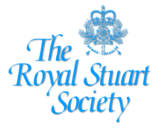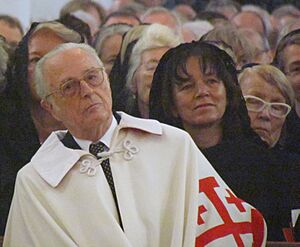Royal Stuart Society facts for kids
 |
|
| Abbreviation | RSS |
|---|---|
| Formation | 1926 |
| Type | Monarchist, Traditionalist |
| Headquarters | Walsingham, Norfolk, England |
|
Governor-General
|
Murray Beauclerk, 14th Duke of St. Albans |
| Website | royalstuartsociety.com |
The Royal Stuart Society is a group in the United Kingdom that started in 1926. It is the largest group that supports the ideas of "Jacobitism." This means they are interested in the old royal family called the House of Stuart. The society's full name is The Royal Stuart Society and Royalist League, but most people just call it the "Royal Stuart Society." They recognize Francis, Duke of Bavaria, as the current head of the Stuart family.
The society holds yearly events to remember important dates related to the Stuart family. They also celebrate other events that are interesting to people who support the idea of monarchy.
History of the Society
After the First World War, the Jacobite movement was not very organized. The Royal Stuart Society was created in 1926 to bring these supporters together. Captain Henry Stuart Wheatly-Crowe helped start the society and became its first leader, called the Governor-General. Other groups that supported the Stuart family also joined in.
The Royal Stuart Society sees itself as continuing the work of older groups. These groups, like the Legitimist Jacobite League and the Order of the White Rose, also wanted to keep the Stuart family's history alive. Some other important people who helped found the society were Lionel Erskine-Young, 29th Earl of Mar, and Reginald Lindesay-Bethune, 12th Earl of Lindsay.
What the Society Does
The Royal Stuart Society has several main goals:
- To welcome anyone who is interested in the members of the Royal House of Stuart, their family, and their supporters.
- To encourage research and learn more about Stuart history.
- To support the idea of Monarchy (having a king or queen) and to oppose republicanism (having a president instead of a monarch).
- To organize special events, talks, and other activities to celebrate Stuart history.
The society describes itself as being "monarchist" and "traditionalist." This means they believe in the importance of a monarch and old traditions.
Who Leads the Society?
As of 2023, the main leader of the Royal Stuart Society is Murray Beauclerk, 14th Duke of St. Albans. He is a descendant of the Stuart monarch King Charles II. King Charles II had a son with Nell Gwyn, and the Duke of St. Albans is from that family line. His son, Charles Beauclerk, Earl of Burford, is also a Vice-President of the society.
Other important Vice-Presidents of the Royal Stuart Society include:
- Princess Lew Sapieha, a noble from Poland and Lithuania.
- Prince Filippo Rospigliosi, 12th Earl of Newburgh, a Scottish noble.
- Count Nikolai Tolstoy, a British historian and a supporter of monarchy. He is also the current head of the Tolstoy family.
- Ian Maitland, 18th Earl of Lauderdale, a Scottish noble.
- Lucius Cary, 15th Viscount Falkland, a British noble and politician.
- Edward Corp, a former history professor from France.
- Lady Antonia Fraser, a well-known British author who writes history books and biographies.
Society Activities

The Royal Stuart Society organizes many events throughout the year. They hold a special service every year on January 30 to remember the execution of Charles I of England. This service takes place at his statue in Trafalgar Square, London. A wreath is also placed on his tomb at St George's Chapel in Windsor.
On February 8, they remember the execution of Mary, Queen of Scots, with a service at her tomb in Westminster Abbey. Sometimes, they also mark the birthday of King James VII and II on October 14. They do this by saying prayers and placing flowers at his statue outside the National Gallery.
The society also holds an annual dinner. This dinner celebrates Restoration Day and White Rose Day, which are important dates in Stuart history. They also organize lectures in London where people can learn more about Stuart history. In the past, the society published a yearly magazine called the Royal Stuart Journal. Before that, they published Royal Stuart Papers, which included articles by famous historians.

